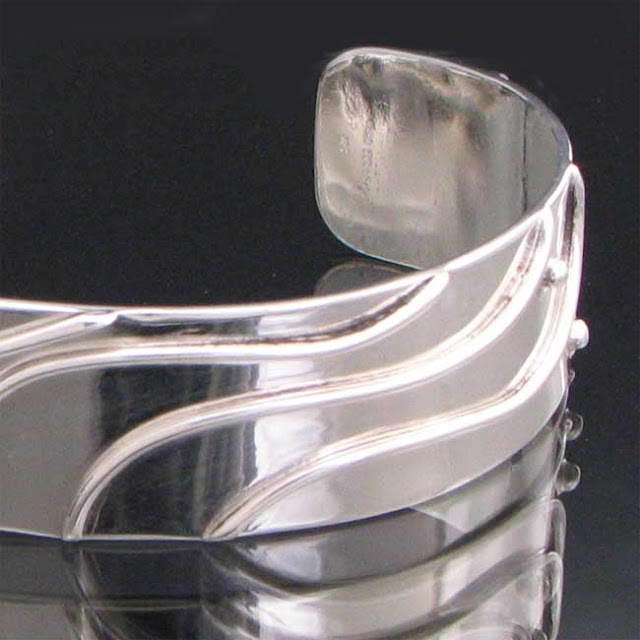Or...The Dirty Secret About Jewelry--Part II
In the previous article, we went over how to clean debris from your jewelry that builds up from lotions, soaps, grime and sweat, using an ultrasonic machine. Now we're going to learn about getting rid of tarnish. It's the special enemy of silver jewelry.
Tarnish. An ionic machine is the perfect solution for this problem.
Tarnish can be gone forever with one of these little beauties!
Ionic cleaners
Oh happy day! They finally have been able to produce these for consumers and they are a godsend! If you have a lot of jewelry, especially silver, an ionic cleaner is relatively inexpensive way to blast off tarnish. It won't do a thing to get the debris off, but it will blast away dulling tarnish and make your metal sparkle again.
Ionic cleaners work electrolytically to remove the tarnish.
In other words, they use a small electrical charge from direct current, an alkaline based cleaner and an anode plate in the bottom of the tank. There is a little clip that is the cathode, that you attach to the jewelry to complete the circuit. You'll know it's working because it will give off little bubbles, and with heavily tarnished silver jewelry, you'll notice the smell of hydrogen sulfide, or the rotten egg odor.
A company that I know sells a true consumer level ionic cleaner is Speed Brite. Their smallest one is called a Mini Speed Brite and it uses a 9 volt battery to power it. You won't have to worry about getting electrocuted with the battery, unlike the ones where you plug in the transformer to regular 110 v AC power. Usual disclaimer that I don't get paid, just personally satisfied with the product.
This one is a commercial one, but it works similar to the consumer version.
 |
| A commercial ionic cleaner in use with the clip on lead attached to the chain laying across the bottom of the tank |
Cleaning chains
This machine is great for cleaning chains, because it can remove tarnish from the inside of the chain links, a boon for something that has very fine links, like a French rope chain. However, if it doesn't remove the tarnish from inside the links, it could mean you have a combination of gunk and tarnish. An ionic cleaner can't remove debris, so you'll have to use some hot water, dish soap and a toothbrush to get rid of the debris so the ionic can get to the tarnish itself. Or use a spiffy ultrasonic machine.
If you're cleaning a chain, you can only clean a long chain a few parts at a time. If the chain crosses over itself, it will deposit the tarnish that it cleaned off the rest of the chain to the part where it crossed itself--and then that part will be really tarnished! So, unclasp the chain, put what you can across the bottom and clean that. Move the clip up to a tarnished area, lay out more of the tarnished part across the bottom and clean a little more.
In this demonstration, I'll show you how a chain is cleaned. First, let me state that this particular chain had an oxidized patina put on it that used several mordants to make the oxidation really stick. In addition, it has also sat around for awhile, so the oxidation is age hardened to the chain. In other words, this type of tarnish is tough to the extreme.
 |
| Extremely tarnished chain |
 |
Here you can see the part of the chain that is clean, next to the original tarnished area
|
One thing you need to be aware of, it will also clean off the oxidation that has been deliberately added to enhance details. So if you have something that has a black finish in the recessed areas, clean in stages of 5 seconds at a time. Make sure you're not cleaning off the detail!
Don't use an ionic cleaner for anodized aluminum, niobium or titanium. It will strip off the lovely colors!
Likewise, there are certain stones that shouldn't be used in an ionic cleaner, like some drusy (druzy) crystals that have been anodized. If in doubt, take your piece of jewelry into a professional jeweler's store and ask.
The chain above was dipped 3 times in the 30 second cleaning cycle, for a total of 90 seconds. Your average tarnished piece with oxidized detail may only take 5-10 seconds.
This machine will also clean gold, platinum, white gold, fine silver, coin silver and a host of just about any metal. It's superb for copper.
Be sure to rinse thoroughly with clean running water. Dry with a soft tea towel or old T-shirt. Your jewelry is bright and tarnish free.
With the next article in this series, we'll be going over low tech methods, also known as elbow grease, and a little kitchen chemistry. Not too much elbow grease though, because frankly, I don't have the time and neither do you!
Copyright 2011 by Katherine Palochak


















































